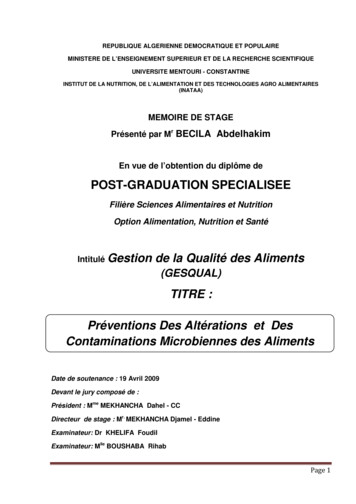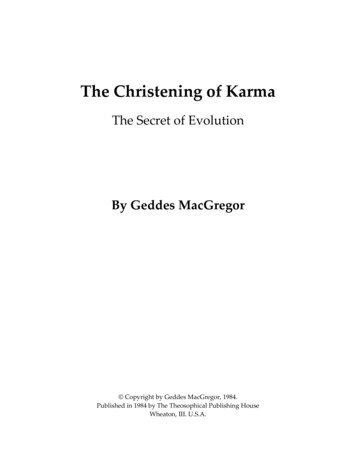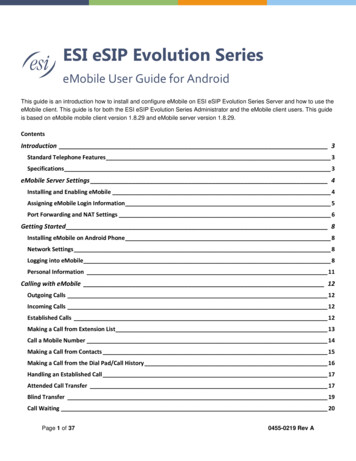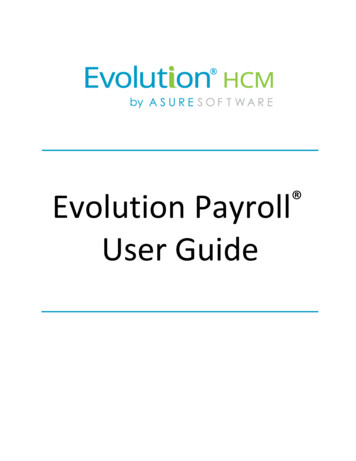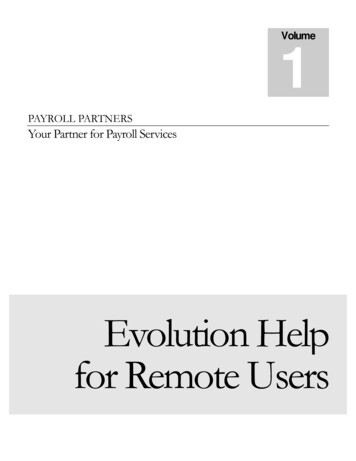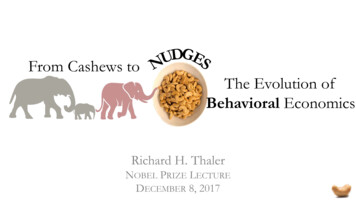
Transcription
From Cashews toThe Evolution ofBehavioral EconomicsRichard H. ThalerNOBEL PRIZE LECTUREDECEMBER 8, 2017
Stories and thought experiments circa 1970sThe dinner party.Conundrum: Why were we happy to have a choice removed?Research topic: Self control (joint research with Hersh Shefrin)Professor Richard H. Thaler2
WineMeet Professor Rosett. Chair of Economics Dept.earlier (1950s) he bought some bottles for 4.95 He can sell a bottle for 100 He never pays more than 30 for a bottle of wine But he sometimes drinks one of his old ones YearsSo he won’t buy, won’t sell, but will drink.Huh?More research topics!The “endowment effect”; loss aversion; status quo bias.Professor Richard H. Thaler3
Driving in the snowA friend and I are given tickets to anbasketball game in Buffalo, 100 kmaway. There is a blizzard. We skipthe game, but my friend says, “if wehad paid full price for those tickets wewould have gone”.Question: Why does going to thegame help?Research topic! Mental accountingProfessor Richard H. Thaler4
A key insight from Kahneman and Tversky Becauseof limited rationality, people usesimple rules of thumb (heuristics) to helpthem make judgments and forecasts. Theuse of these heuristics leads tosystematic errors (biases). Randomerrors would not matter toeconomic theory, but systematic error is abig deal.Professor Richard H. Thaler5
Supposedly Irrelevant FactorsOne lesson from my stories is that some things that economic theory says shouldnot matter actually do matter:“Supposedly Irrelevant Factors” (SIFs) Movingthe cashews across the table should not matter. ProfessorRosett’s willingness to drink a bottle of wine should notdepend on whether he owns such a bottle (assuming he can buyand sell at the same price). Ourwillingness to go to the game should not depend onhow much we paid for the tickets. Sunk costs are SIFs.Once we realize that SIFs are not irrelevant, the power of economics is increasedsince more things “matter”.Professor Richard H. Thaler6
Going beyond stories and thought experimentsExperiment with Daniel Kahneman and Jack KnetschProfessor Richard H. Thaler7
20 18 9 8Professor Richard H. Thaler 15 5 15 12 10 3 2 08
20 18 15 15 12 10 3 2 0Randomassignment 9Professor Richard H. Thaler 8 59
20 18 15 15 12 10Coase Theorem—NobelConduct 1991—worksa market. for tokens! 9Professor Richard H. Thaler 8 5 3 2 010
20 18 9 8Professor Richard H. Thaler 15 5 15 12 10 3 2 011
20 18 15 15 12 10 3 2 0Randomassignment 9Professor Richard H. Thaler 8 512
20 18 15 15 12 10If Coase Theorem worked 9Professor Richard H. Thaler 8 5 3 2 013
20 18 15 15 12 10EndowmentEffect– lossaversion & inertia!Whatreallyhappened? 9Professor Richard H. Thaler 8 5 3 2 014
The endowment effect and status quo biasToken experiments:Markets worked just asin text books. LossMugs experiments:Too little trading initialassignments seem “sticky”!Why?aversion: Mug owners demanded about twice as much togive up their mugs as non-owners were willing to pay to get one. Status quo bias, the tendency to stick with what you have. Other reinforcing factors: Thecomfort of the known vs. the unknown. Inattention, laziness and procrastination. Example: television watching.Professor Richard H. Thaler15
Bounded rationality and bounded willpowerWhat if Humans are not as smart as Einstein?What if they (occasionally) submit to temptation?Consider the “Life-Cycle Hypothesis” Modigliani Nobel 19851. Figure out how much you expect to make over your lifetime, andhow long you plan to work.2. Decide how you would like to spread your earnings over yourlifetime.3. Implement this plan!Professor Richard H. Thaler16
A simple example Professor Richard H. Thaler20Dissaving30405060708017
Unexpected income disruptionsStartupBoom! Income(Actual)Income(Planned)Professor Richard H. 8
Self-control and savingsMust calculate, update, have willpower Buy asports carKids moveback sor Richard H. Thaler304050Old age issues 60708019
This is HARD, how to HELP? Formost of Human history, people did not live long enough to worryabout retirement saving. Thosethat did, moved in with their kids, who lived nearby. 20thcentury solutions as parents started living longer and the kidsbegan leaving home: Statesponsored social security Definedbenefit company pensions Thesesolutions required virtually no decisions or self-control bycitizens/employees.Professor Richard H. Thaler20
The rise of defined contribution systems Employersand governments introduce defined contribution plans inwhich Humans have to make decisions on whether to join, howmuch to save, and how to invest. Difficult! Problems: Somepeople fail to join. Even for those who join, they may not save enough to invest wisely. Note:the traditional life-cycle model offers no help in solving theseproblems because it assumes people are already saving just theright amount! Howcan behavioral economics help?Professor Richard H. Thaler21
One solution: Choice Architecture(Thaler & Sunstein, 2008) Choicearchitecture is the environment in which people makedecisions. Someexamples: Menus StoreLayouts On line shopping web sitesarchitecture can include nudges, features of the environmentthat influence Humans but not Econs (short for homo economicus). Choice Notethat nudging is choice preserving. No one is forced to doanything! Libertarian paternalism is not an oxymoron!Professor Richard H. Thaler22
Powerful nudge: Change the default Thedefault is what happens if you do nothing. (Humans are goodat doing nothing.) Olddefault in retirement savings plans—you have to fill in forms tojoin. Filling in forms is nasty. Newdefault—automatic enrollment. You are enrolled unless youopt out. This is a nudge. Does it work?Professor Richard H. Thaler23
Participation rates by employee income(Vanguard Defined Contribution plans)Over 100k 75k- 99k 50k- 74k 30k- 49kLess than untary enroll*VanguardProfessor Richard H. Thaler24
Problem with automatic enrollment Mostfirms enroll people at too low of a savings rate, often3% in U.S. Approachnature.to solving the problem? Use knowledge of human Weknow people have more self-control for the future—not today! Loss aversion—people hate to see their paycheck fall. Inertia. People get stuck.Professor Richard H. Thaler25
Save More Tomorrow(Thaler and Benartzi, 2004)Basic Idea: invite people to join a plan in which they will save more in thefuture whenever they get a raise. Increases continue until cap is reachedor person opts out.1.In first implementation, participants were offered free financial advice. Mostemployees were advised to increase their saving by 5 percentagepoints.2.Save More Tomorrow was offered only to those who rejected thisadvice. Increasesaving rate by 3% at each raise.Professor Richard H. Thaler26
Effects of Save More Tomorrow programSavings rates ofparticipants who Declined offer offinancial adviceAfter 1st 2nd pay 3rd payInitiallypay raise raiseraise4th payraise6.66.56.86.66.2Took the consultant’srecommended savingsrate4.49.18.98.78.8Joined the “Save MoreTomorrow” plan3.56.59.411.613.6*Benartzi and Thaler (2004)Professor Richard H. Thaler27
Yes, but Policiessuch as automatic enrollment and Save MoreTomorrow appear to strongly influence behavior, but what ifpeople are just moving money around and saving lesselsewhere or borrowing more? Thisquestion has been impossible to answer until RajChetty and colleagues investigated with Danish data.Professor Richard H. Thaler28
128Δ Employer Pensions 5.644Employer Pensions0Contribution or Taxable Saving Rate (% of income)Event Study around Switches to Firm with 3% Increase in Employer Pension Rate Individuals with PositivePension Contributions or Savings Prior to Switch-4Professor Richard H. Thaler-20Year Relative to Firm Switch24*Chetty et al (2014)29
128Δ Employer Pensions 5.64Δ Individual Pensions -0.564Employer PensionsIndividual Pensions0Contribution or Taxable Saving Rate (% of income)Event Study around Switches to Firm with 3% Increase in Employer Pension Rate Individuals with PositivePension Contributions or Savings Prior to Switch-4Professor Richard H. Thaler-20Year Relative to Firm Switch24*Chetty et al (2014)30
128Δ Employer Pensions 5.64Δ Taxable Savings 0.024Employer PensionsTaxable Saving0Contribution or Taxable Saving Rate (% of income)Event Study around Switches to Firm with 3% Increase in Employer Pension Rate Individuals with PositivePension Contributions or Savings Prior to Switch-4Professor Richard H. Thaler-20Year Relative to Firm Switch24*Chetty et al (2014)31
How long do nudges last? A test in Sweden In2000 Sweden launched the Premium Pension System Keyfeatures: 2.5%of pay is directed into a defined contribution retirementsavings plan, as a part of the social security system (total payrolltax of 16%). Over 450 funds were offered.Professor Richard H. Thaler32
The Battle of the Nudges Nudge#1. In the 2000 launch, a default fund was selected (AP7) foranyone not wishing to make a choice or for those who did not activelychoose. We will call those who take the default fund Delegators. Nudge#2. The government urged citizens to form a portfoliothemselves. We will call these people Self Directed. Boththe government and private funds advertised widely. Thegovernment urging people to actively choose, the funds to choosetheir fund. Theads from individual funds were primarily uninformative.Professor Richard H. Thaler33
Harrison Ford Offers Investment AdviceProfessor Richard H. Thaler34
Which nudge won? Two-thirdsof citizens chose to form their own portfolios. Insubsequent years, as new people joined the system, anincreasing proportion chose the default fund.Professor Richard H. Thaler35
Investor behavior: Initial choices70%Two-thirds of those who started in2000 picked their own portfolios.60%50%40%But in recent years, almost no one iselecting to be f-Directed (%)Professor Richard H. Thaler36
Long-term effects of nudges for initial investors Werethe initial choices sticky? 27%of those in the default fund have left it, to become selfdirected.only 3% of those making self-directed choices switched tothe default. ButProfessor Richard H. Thaler37
What happens if you add leverage?In 2010 the managers of the default fund added 25% leverage,then upped it to 50% in 2011. 50% leverage means: If the market goes up 10%, the fund goes up 15% If the market falls 10%, the fund falls 15% If this were in place in 2006-8 the fund would have lost 82%!In 2015 the leverage was reduced to 25%. One of the (now 900) funds available was virtually identical tothe default fund without leverage. Did any investors notice the leverage and switch?Professor Richard H. Thaler38
0,8Volume ofinvestors whosold AP7Professor Richard H. 720172017Leverageover 172017We cannot reject the hypothesis that 3 millionSwedish investors in the default fund are 10039
Implications of the Swedish experience1.Nudges can be very powerful.2.Their effects can be long lasting.3.New marketing campaign Professor Richard H. Thaler40
NUDGES ARE FOREVERProfessor Richard H. Thaler41
Conclusion Itis possible to do economics without homo economicus. Understandinghuman nature can improve the explanatorypower of economic theory, and help us devise solutions topublic policy problems. Inshort, we can nudge for good.Thanks to everyone who helped. And as Danny alwayssays, “to be continued ”As you can see, Danny and I will remain hard at work.Professor Richard H. Thaler42
Professor Richard H. Thaler43
Professor Richard H. Thaler 20. This is . HARD, how to . HELP? For most of Human history, people did not live long enough to worry about retirement saving.


